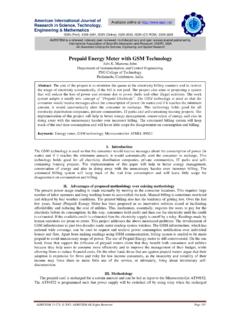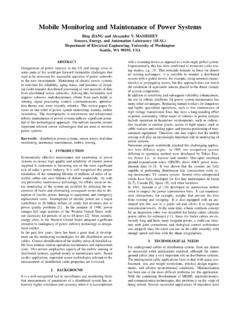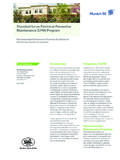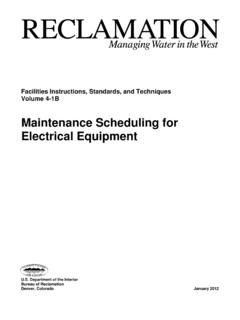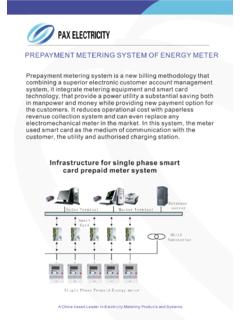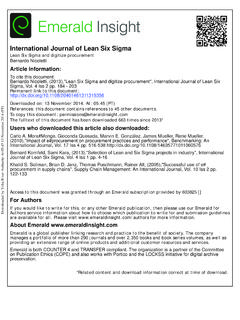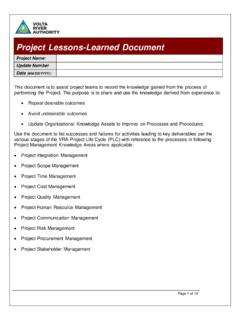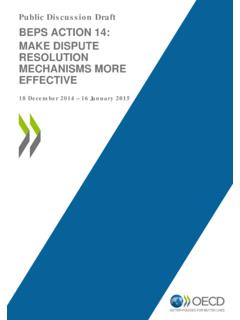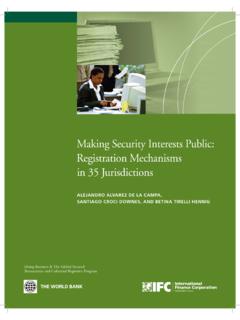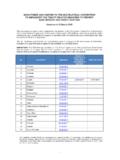Transcription of Performance Improvement Planning Developing …
1 Improving billing and collection activities has an immediate impact on the revenue streams of a serviceprovider that can, in turn, encourage commercial and operational efficiencies for aiding the expansionand delivery of improved, reliable, and sustainable services. This note draws on national andinternational cases to explore what it takes to implement an effective billing and collection Improvement PlanningDeveloping effective Billingand collection PracticesApril 2008 Field NoteThe Water and Sanitation Programis an international partnership forimproving water and sanitation sectorpolicies, practices, and capacities toserve poor peopleContextMost Indian water utilities1 and serviceproviders are under severe financialstrain, with insufficient funds for routinemaintenance, replacement, andexpansion. Poor financial health is aresult of a number of factors includinginefficient operations, poor levels and/orabsence of metering, poor billing andcollection practices, poor structure andlevels of water tariffs, increased andinefficient operational costs, andweak and collection systems henceare critical for ensuring financialsustainability and for achieving costrecovery, especially if a service provideris looking to expand services andimprove the equity of service India, the impact of poor billing andcollection is reflected through longcollection periods.
2 Water boards inBangalore and Delhi report collectionperiods of more than five months,while Chennai and Mumbai reporteven longer, at and eightmonths, India, poor billing and collectionpractices primarily emanate from thelack of incentives for the serviceprovider to even charge for servicesbeing delivered and the lack of apolitical will to set tariffs that wouldallow for recovering the costs incurredin supplying the service. Most serviceproviders do not have well-defined andproper financial records for waterEffective billing and collection systems are a critical component for ensuring theviability of a service provider. Improving these has an immediate impact on therevenue streams of a service provider that can, in turn, help in improving SummaryWater utilities and service providers in India are plagued withsevere deficiencies in the delivery of services, with access toreliable, sustainable, and affordable water supply and sanitationservices remaining poor in general.
3 The sector s worryingperformance is caused, among other reasons, by financial andcapacity constraints, including the absence of a commercialorientation to services, institutional deficiencies, and the lackof systemic incentives to deliver ongoing quality billing and collection systems are a critical componentfor ensuring the viability of a service provider. Improving billingand collection activities has an immediate impact on therevenue streams of a service provider that can, in turn, help theservice provider in improving services. However, while effectivebilling and collection practices depend on many internal factors(including customer databases, the extent of metered andunmetered service provision, tariff and billing structures,delivery of bills, and facilities for customer payments), theinstitutional arrangements under which service providersoperate and provide services determine whether such practiceswill remain sustainable in the long term.
4 Efficient billing andcollection practices can set incentives for the provider toeffectively charge and collect water bills while also fulfilling acommercial orientation to note draws on national and international cases to explorewhat it takes to implement an effective billing and collectionsystem that encourages commercial and operationalefficiencies for aiding the expansion and delivery of improved,reliable, and sustainable services. The note starts with anexplanation of how poor billing and collection hurt the serviceprovider, followed by the key principles of an effective billingand collection strategy, illustrated through national andinternational billing and collection In the Indian context it is difficult to draw a parallel to thecommon definition for a utility as used in the internationalcontext. For the purpose of discussion in this paper, utility isdefined as an organization that is majority owned andcontrolled by the government and could consist of differentforms, some of which may be undistinguished from thegovernment unit that they may be part of.
5 It could also mean aspecially carved out unit in the municipal body involved withthe delivery of municipal services, water being one of Water and Sanitation Program-South Asia s BenchmarkingProject, Phase I, Improvement Planning : Developing effective Billingand collection PracticesThe basic aim of the Performance Improvement series is to help water utilities and service providers understandand adopt mechanisms that promote cost recovery and sustainable revenue strategies, as well as help achieve financiallyviable and sustainable improved services. The objective is to be able to focus not only on specific performanceimprovement areas by advancing technical, commercial, and operational efficiency such as leak reduction, billingand collection , customer service, and tariff setting, among others but also ensure that such improvements remainsustainable and viable in the long term through arrangements such as Performance agreements, monitoring,and No.
6 2 focuses on the importance of effective billing and collection , the common pitfalls that their poorimplementation have, and what some service providers have done to improve upon current billing and collectionpractices through measures including robust recordkeeping and billing procedures, updating customer databases,outsourcing billing activities and using improved technology, and encouraging and incentivizing staff to undertake billingand collection functions more 1: Why is effective Billing and collection Necessary?supply and sanitation (WSS) servicedelivery. Many service providers alsocarry out responsibilities for supplyingWSS services as one of the variousother functions and, therefore, do notkeep separate accounts for recordingall activities connected with the WSSresponsibility. Since they have noseparate budgets or accounts forWSS services, any revenue-enhancingreforms fail to encourage andincentivize WSS staff to take forth suchinitiatives since financial deficienciescan be cross-subsidized from othermunicipal account flows.
7 They are notincentivized to collect charges, eitherbecause of the absence of any setrevenue targets or because of virtuallyunconditional financial support fromgovernment. Only when institutionalarrangements approach water supplyservice delivery as a commercialendeavor will the appropriate incentivesto effectively charge, bill, and collect forservices be the broader institutionalenvironment can enhance or constrainthe effectiveness of billing andcollection practices, specific provider-level inefficiencies could also hamperthe efficiency of such providers may lack importantinternal controls for timely, accurate,and transparent billing andcollection practices. They sometimesdo not have updated, accurate, andcomplete computerized listings of thecustomers they are serving, thusmaking accurate billing almostimpossible. Such mechanisms mayalso be ineffective because of thestructure of tariffs as well as theabsence of metered connections.
8 Poorcollection practices also result from alack of willingness on the part ofconsumers to pay because of the poorquality of services and the poorcustomer care they receive, or fromsubstandard collection systems thatare cumbersome and not transparent,thus disincentivizing paymentof when institutional arrangements approach water supply service deliveryas a commercial endeavor will the appropriate incentives to effectivelycharge, bill, and collect for services be do PoorBilling andCollectionPractices Hurtthe Provider?A Routine Exercise?More often than not, water serviceproviders consider billing and collectionactivities a routine exercise that theyneed to undertake; hence, they do nothave a proactive attitude regardingsuch practices. There is an inclinationtowards considering that poor andinadequate services need to be tackledthrough the more popular issuesof leakage management andrationalization of input costs, since thedelivery of water services is seen moreas an engineering task; no one givesfinances, billing, and collectioninadequate processes and systems orunwilling customers who default onpayments because they are dissatisfiedwith the services they billing and collection rates isone of the key tools for enhancing therevenue base of the utility, achievingfinancial viability, and sustainability andhence registering improvements inservices delivered.
9 Service providerswill need to realize that the benefits ofefficient billing and collection practiceson their operations is almost instantand can, in fact, improve the revenueaccounts of the utility almostimmediately. It is in this aspect that theimportance of revenue sufficiencycannot be InefficienciesWhile the most significant impact ofpoor billing and collection practices isprobably on revenue adequacy andcost recovery, thus resulting in poorstandards of services, ineffective billingand collection practices also result insuboptimal results and operationalinefficiencies. Given that every serviceprovider must spend time andresources on billing and collectionfunctions, any ineffective initiative willresult in cost inefficiencies. Forinstance, resources may be put intocomputerizing and updating customerdatabases and customer records, butif the utility still fails to bill and collecteffectively, then all efforts for updatingrecords are improvements in undertaking billingand collection practices effectively willthus help in bringing down the costsper unit of billing and collection andmake such practices worth theresources that are allocated and and poorly managed billingand collection practices also impactpractices, among others, a secondthought.
10 However, reforms targetingrevenue-enhancing strategies mustemphasize that effective billing andcollection practices are important ifwater providers are targeting full costrecovery and financial sustainability,especially for improving service qualityand Inadequacy,Poor Cost Recovery,and Poor ServicesPoor billing and collection practicesprevent water utilities from recoveringsufficient costs to properly operate andmaintain facilities and, therefore,provide adequate service to thecustomer. Many water utilities in thecountry today fail to accurately bill forevery unit of water produced, either onaccount of the lack of any incentives tobill or for other internal factors suchas inadequate customer records, Performance Improvement Planning : Developing effective Billingand collection Practices5staffing costs and staff efficiency utility may be allocating some staff forcarrying out billing and collectionfunctions, but if such practices are noteffectively targeted and do not result inimproved collection efficiencies, thensuch efforts will have suboptimal BankabilityPoor billing and collection practicesthat result in huge commercial lossesand operating inefficiencies also hurtthe creditworthiness of many waterservice providers, affecting theirbankability and ability to tap thefinancial markets.
